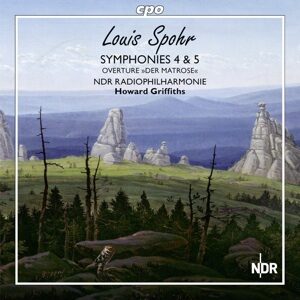Spohr subtitled his Fourth Symphony “The Consecration of Tone: Characteristic Tone Painting in Symphonic Form”, and prefaced it with a long-winded poem of the same title that he requested be distributed and (if possible) recited before any performance. It is quite simply one of the most aesthetically confused pieces of music ever conceived, in which the expressive ends remain completely at odds with the formal means. Spohr was, of course, a major figure in German music in the first half of the 19th century, for a brief time the major figure, but whatever else his virtues as a man and an artist (and he had many), he was a miserable symphonist.
The Consecration of Tone begins with a slow introduction, sort of like that to Beethoven’s Fourth Symphony, but without any of the mystery or tension. A fluent and conventional allegro then ensues, with a second subject based entirely on stylized birdsong–the sounds of nature mentioned in the poem. Both the key (F major) and the birds reflect Beethoven’s Sixth, but here they twitter and chirp for way too long, and the horn makes a lousy cuckoo. The entire exposition is, of course, repeated, before a short development introduces a vaguely darker tone, and then all of the initial material comes back in regular order. The following slowish movement is a brief lullaby, dance, and serenade, all of which are mentioned in the poem and so have to be strung together here, albeit charmingly.
Next comes a “war and lament and victory” march cast in simple ABA form, with a strangely repetitious and expressively neutral trio section that goes on for far too long, before the original march comes back. It thus depicts the horrors of a nice, amiable, war. The finale starts with a short and emotionally dry funeral march, and then proceeds to a placid Allegretto conclusion that peters out to nothing in the final bars, practically defining the term “anti-climax”. The entire business takes nearly 40 minutes, and it was one of the greatest hits of the 1830s. Its popularity rapidly declined, however, everywhere except in Victorian England, where its persistence in London Philharmonic Society programs through the 1880s tells you everything that you need to know about its true value.
The Fifth Symphony in C minor demonstrates Spohr’s determination to repudiate the symphonic style of Beethoven, the finale of whose Fifth Symphony in C minor he particularly detested as ugly, ignoble, and inartistic. Don’t take the C minor promise seriously in Spohr’s case. The work is an essay in blandness, vacillating wimpishly between major and minor (mostly major), with a finale containing an endlessly distended fugue seemingly based on a thematic fragment from the finale of (maybe) one of Haydn’s “London” symphonies. Spohr was constitutionally incapable of being dramatic or surprising, and for all the lovely scoring and graceful instrumental solos you never get the feeling that he is writing effectively for a large ensemble. As the “anti-Beethoven” this is tremendously and depressingly successful.
The performances are Spohr-like. Griffiths leads graceful, fluent interpretations of both works that tend to magnify their already glaring faults. Spohr marks the entrance of the percussion (bass drum, cymbals, snare drum, and triangle) in the march in “The Consecration of Tone” with a rare fortissimo for a few bars. It should be a Big Moment, but Griffiths downplays the dynamic contrasts throughout. Perusing the scores while listening, you can see countless moments where surely the music could take a bit more muscle than it gets here. Oh yes, there’s also a brief overture to “Der Matrose” (“The Sailor”) that I forgot about immediately on hearing it, and so will you. Excellent SACD engineering makes no difference whatsoever.
































